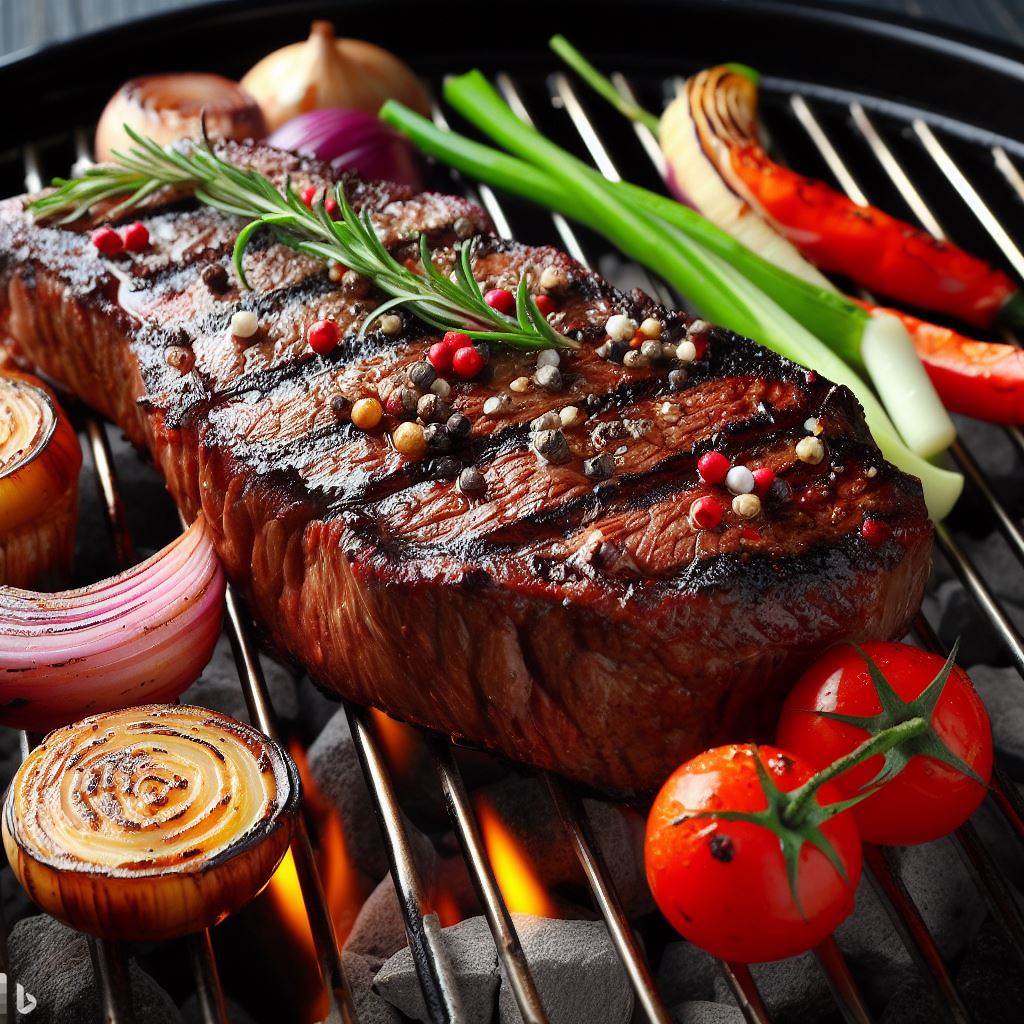
If you’re craving a delicious, juicy skirt steak cooked to perfection, then look no further than your trusty charcoal grill. You may be wondering how long it takes to grill a skirt steak to a tender, medium-rare doneness on a charcoal grill.
Well, fear not because in this article, we’ll reveal the ideal cooking time and share some handy tips to ensure your skirt steak is mouthwateringly flavorful and cooked to perfection every time.
So grab your apron, fire up the grill, and get ready to impress your friends and family with your grilling skills.
Choosing and Preparing the Skirt Steak
Selecting the Skirt Steak
When choosing a skirt steak for grilling, it’s important to look for a well-marbled piece of meat. This marbling will add flavor and moisture to the final dish. Additionally, consider the thickness of the steak; a thinner cut will cook more quickly, while a thicker cut may require longer cooking time.
Trimming the Skirt Steak
Before you can start grilling, it’s essential to trim any excess fat or silver skin from the skirt steak. This will prevent flare-ups and ensure a more consistent cooking process. Use a sharp knife to carefully remove any unwanted pieces, making sure to leave a thin layer of fat on the steak for added flavor and juiciness.
Seasoning the Skirt Steak
To enhance the natural flavors of the skirt steak, it’s important to season it before grilling. A simple salt and pepper seasoning is often enough to bring out the meat’s delicious taste.
However, feel free to experiment with different dry rubs or marinades to add additional flavors. Just remember to let the steak sit at room temperature for about 30 minutes after seasoning before grilling.
Preparing the Charcoal Grill
Setting up the Charcoal Grill
Before lighting the charcoal, it’s crucial to properly set up your grill. Choose a safe and well-ventilated area, away from any flammable objects. Place the grill on a stable and heat-resistant surface. Make sure all the vents on the grill are open to allow for proper airflow, which will aid in controlling the temperature.
Lighting the Charcoal
To light the charcoal, use either a chimney starter or lighter fluid. If using a chimney starter, simply fill it with charcoal and place a piece of crumpled newspaper in the bottom.
Light the newspaper from the bottom and allow the charcoal to ignite. If using lighter fluid, arrange the charcoal in a pile, drizzle the fluid over it, and carefully ignite with a long-handled match or lighter.
Heating the Grill
Once the charcoal has ignited and started to ash over, it’s time to spread the coals evenly across the bottom of the grill. This will create an even heat distribution. Place the grill grates on top of the charcoal and allow them to heat up for a few minutes before starting to grill.
Direct Heat Grilling
Creating Direct Heat Zones
When grilling skirt steak, it’s important to create different heat zones on the grill. This will allow you to control the level of doneness more effectively.
To create direct heat zones, arrange the charcoal in a way that one side of the grill has more coals, creating a higher heat zone, while the other side has fewer coals, creating a lower heat zone.
Preheating the Grill
Before placing the skirt steak on the grill, make sure the grill grates are well-preheated. This will help prevent sticking and ensure proper searing.
Close the lid of the grill and let it preheat for about 10-15 minutes. The grill should reach a temperature of around 400-450 degrees Fahrenheit.
Grilling the Skirt Steak
Once the grill is preheated and the charcoal is ready, it’s time to start grilling the skirt steak. Place the steak directly over the higher heat zone to sear it quickly and develop a flavorful crust. Leave the steak in place for about 2-3 minutes.
Then, using tongs, flip the steak over and move it to the lower heat zone. Grill for an additional 2-3 minutes for medium-rare doneness or adjust the cooking time to your preferred level of doneness.
Determining Cooking Time
Consider the Thickness of the Skirt Steak
The cooking time for skirt steak will depend on its thickness. Thinner steaks, around 1/2 inch, will cook more quickly, while thicker steaks, around 1 inch or more, will require a longer cooking time. It’s essential to keep this in mind to ensure that the steak is cooked perfectly to your liking.
Using a Meat Thermometer

To ensure accurate cooking time and to achieve the desired level of doneness, using a meat thermometer is highly recommended. Insert the thermometer into the thickest part of the skirt steak, avoiding any bones or large pockets of fat. For medium-rare doneness, aim for an internal temperature of around 130-135 degrees Fahrenheit.
Monitoring the Level of Doneness
While a meat thermometer is helpful, it’s also important to pay attention to visual cues to determine the doneness of the skirt steak. As the steak cooks, you will notice changes in color and texture on the surface of the meat. For medium-rare, the steak should have a red, warm center, with lightly browned edges and a slightly firm texture.
Achieving Medium Rare Doneness
Cooking Time for Medium Rare
To achieve medium-rare doneness, you’ll want to cook your skirt steak for approximately 2-3 minutes on each side, depending on thickness and grill temperature. However, keep in mind that cooking times may vary, so it’s important to adapt based on the specific heat of your grill and the desired level of doneness.
Checking the Internal Temperature
To ensure that your skirt steak is cooked to medium-rare perfection, check the internal temperature using a meat thermometer.
Aim for a reading of around 130-135 degrees Fahrenheit. Remember that the temperature will rise slightly as the steak rests, so it’s important to remove it from the grill a few degrees below your desired doneness.
Resting the Skirt Steak
After grilling your skirt steak, it’s crucial to let it rest before slicing and serving. This allows the juices to redistribute throughout the meat, resulting in a more tender and flavorful final dish. Place the steak on a cutting board and loosely cover it with aluminum foil. Let it rest for about 5-10 minutes before slicing.
Tips for Grilling Skirt Steak
Marinating for Extra Flavor
If you want to enhance the flavor of your skirt steak, consider marinating it before grilling. A marinade can add various flavors to the meat, such as garlic, herbs, citrus, or soy sauce.
Simply place the skirt steak in a resealable bag or a shallow dish, add your desired marinade, and refrigerate for at least 30 minutes or up to 24 hours before grilling.
Avoiding Overcooking
Skirt steak is best enjoyed when cooked to medium-rare or medium doneness. To avoid overcooking, keep a close eye on the time and temperature.
Remember that skirt steak continues to cook slightly even after being removed from the heat, so it’s better to take it off a few degrees below your desired doneness to achieve the perfect outcome.
Slicing Against the Grain
To ensure that your skirt steak is tender and easy to chew, it’s important to slice it against the grain. The grain refers to the lines or fibers visible on the surface of the meat.
By slicing against these lines, you break up the muscle fibers and create shorter pieces, resulting in a more tender and enjoyable eating experience.
Alternative Grilling Methods
Indirect Heat Method
While direct heat grilling is the most common method for cooking skirt steak, you can also opt for indirect heat. Indirect grilling involves placing the steak away from the direct heat source, allowing it to cook more slowly.
This method is particularly useful for thicker cuts of skirt steak, as it helps ensure even cooking and prevents burning.
Reverse Searing Method
The reverse searing method is another alternative for grilling skirt steak. This method involves slow-cooking the steak at a low temperature first, either in an oven or indirect heat on the grill, until it reaches the desired internal temperature. Once cooked, the steak is then seared quickly over high heat to develop a crust and enhance flavors.
Using a Grill Pan


If you don’t have access to a charcoal grill, or simply prefer a different cooking technique, a grill pan can be a great alternative. A grill pan allows you to achieve grill-like marks and flavors on your skirt steak without the need for an outdoor grill.
Preheat the grill pan over medium-high heat, grill the skirt steak for a few minutes on each side, and finish cooking in the oven if needed.
Serving and Enjoying Skirt Steak
Resting and Slicing the Skirt Steak
After the skirt steak has rested, it’s time to slice and serve it. Using a sharp knife, slice the steak against the grain into thin strips. This will ensure tenderness and make it easier to bite into. Arrange the sliced steak on a serving platter or individual plates, ready to be enjoyed.
Garnishing and Presentation
To enhance the visual appeal of your skirt steak, consider adding some garnishes. Fresh herbs such as parsley or cilantro can add a pop of color, while a sprinkle of flaky sea salt can enhance the flavors. Additionally, you can garnish with slices of citrus or grilled vegetables to complement the dish.
Serving with Sides and Sauces
Skirt steak pairs well with a variety of sides and sauces. Traditional accompaniments include grilled vegetables, roasted potatoes, or a crisp salad.
Additionally, consider serving the steak with chimichurri sauce, a flavorful blend of herbs, garlic, oil, and vinegar. The tangy and herbaceous sauce complements the rich and smoky flavors of the skirt steak perfectly.
Cleaning and Maintaining the Grill
Removing Residual Ashes
Once your grilling session is over and the grill has cooled down, it’s important to clean out any residual ashes. Remove the grill grates and use a brush or scraper to remove any remaining ashes. Dispose of the ashes in a safe and appropriate manner.
Scrubbing the Grates
To maintain your grill and prevent any buildup that can affect the flavors of future grilling sessions, it’s essential to clean the grill grates. Use a grill brush or scrubber to remove any food particles or residue stuck on the grates. For stubborn grime, you can also use a mixture of warm water and dish soap.
Storing the Grill Properly
To ensure the longevity and optimal performance of your charcoal grill, proper storage is necessary. If possible, store the grill in a covered area, such as a shed or garage, to protect it from the elements.
Additionally, consider using a grill cover to provide extra protection and prevent rusting. Proper storage will extend the lifespan of your grill, allowing you to continue grilling delicious skirt steaks for years to come.
Experimenting with Flavors
Adding Wood Chips for Smoky Flavor
If you want to take your skirt steak to the next level, consider adding wood chips to your charcoal grill. Soaking the wood chips in water before grilling will create a smoky flavor that infuses the meat. Hickory, mesquite, or cherry wood chips are popular choices that pair well with skirt steak.
Using Different Seasonings
While a simple salt and pepper seasoning is classic and delicious, don’t be afraid to experiment with different seasonings. You can try spice blends, such as Cajun or Mexican seasonings, to add a unique kick to your skirt steak. Alternatively, consider using herbs like rosemary, thyme, or paprika to elevate the flavors.
Trying Different Marinades
Marinades are a fantastic way to infuse additional flavors into your skirt steak. From tangy and citrusy marinades to savory and spicy blends, the options are endless.
Try marinating the skirt steak in teriyaki sauce, balsamic vinegar, or even a beer-based marinade. Allow the steak to soak up the flavors for at least 30 minutes overnight before grilling for maximum flavor impact.
By following these steps and experimenting with different flavors and techniques, you’ll become a grill master when it comes to cooking skirt steak. Enjoy the delicious results and impress your friends and family with your grilling skills!









